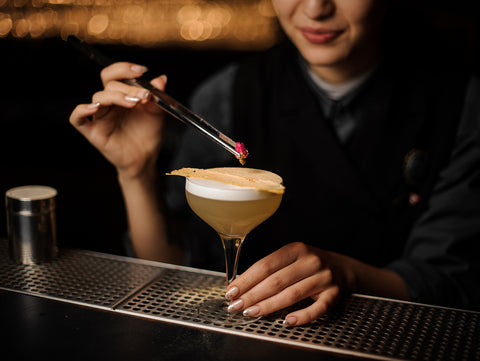As leaves turn, days get cooler, and nights fall sooner, you might have acclimated your bartending without even thinking about it. Maybe you’ve traded your icy, spritzy summer drinks for richer, more warming ones. You might have dusted off your barrel-aged spirits, and furloughed clear liquors you made good use of all summer. And you might just mix stronger, more spirit-driven drinks across the board.
Turning flavors from summer to fall, however, is less cut and dry. Spirits, syrups, and cultivated herbs are mostly evergreen, and so are most cocktails: outside of frozen Margaritas, Hot Toddies, and Egg Nog, Americans enjoy most drinks all year round. Plus, those complex spirits that do have distinct fall components have those of other seasons, too, whether that’s in the diverse botanical recipe of a gin, or in the layered aroma of an aged rum.
Let’s dig in and find some ways you can specifically evoke fall in your cocktails.
ADJUST YOUR GIN
There are gins purpose-built for summer and winter, but a few just happen to start from fall-friendly recipes.

The Scottish brand Darnley’s View makes a unique “Spiced Gin” with a recipe that adds angelica and grains of paradise to familiar culinary warming spices. London’s Oxley Gin features a related botanical profile in an overall more mellow and sweetly-spiced preparation. Both are good choices with tonic or soda in cool weather; in a Negroni with a similarly spicy red vermouth like Gonzalez Byass; or in a Martini with any crisp dry vermouth that lets the gin’s botanicals take the lead.
Process makes other gins fall-friendly. Aged Genever and Old Tom gin, much like barrel-aged tequila and rum, trade the dry and crisp for rich flavor and texture. If you want to stick to a clear spirit, non-barrel-aged bottlings like Boomsma Jonge Genever and Hayman’s Old Tom move the profile more gently in the same direction.
MULL YOUR WINE
In Thomas Dudley Fosbroke’s 1825 classic Encyclopedia of Antiquities, he lays out the Roman process for aging wine in glass or pottery for a minimum of two years, thickening the wine to the point it needed dilution. Once strained, boiled over a low fire, and seasoned with spices and honey, this “Mulsum,” or mulled wine, “was a favorite Roman beverage.”

You can lean on the aging already done by the maker of the wine you buy, and have a delicious and warming batch of cocktails ready for an event in much less time. Start with a inexpensive, gentle red from Beaujolais, Tempranillo, a lighter Merlot or Carmenere, or your favorite boxed wine if it’s not too heavy. You can sweeten the pot with honey, some variety of sugar, or even entirely with a liqueur, depending how thick, how sweet, and how alcoholic you prefer it. The botanical profile is also up to you, though cinnamon sticks, star anise, allspice berries, cardamom pods, cloves, and citrus peels are all safe bets. You may wish to add fresh fruit juice, whether with citrus slices or with Real Grenadine, as in this recipe for Pomegranate Mulled Wine.
If you want to show your guests new ways to enjoy mulled wine, especially when the weather turns warm, be a Roman. Simmer and stir the finished wine until it’s reduced to syrup. Then add ten dashes Angostura or Peychaud’s bitters and two ounces of aged rum, brandy, or whiskey per 750mL of wine you began with, let it all cool, and strain it. This process, outlined by Carey Jones and John McCarthy in Food & Wine, is the start of their recipes for three mulled wine cocktails including a beautiful Sour.
DISTILL YOUR CIDER

Apple brandy - whether it fortifies your mulled wine or serves as a base spirit - is a great way to evoke the fall harvest in your cocktails.
Both apple cider and its brandy are rich French and American traditions, although they’ve had opposite fortunes.
Scotsman William Laird introduced applejack brandy to colonial America in 1698. It took off; there were once hundreds of American producers. Now, apple cider is booming here, but whiskey and rum - both distilled from cheaper and much more forgiving crops - supplanted apple brandy long ago.
In Normandy, locals had by the mid-16th century distilled the cider that the local Vikings had enjoyed at the turn of the millennium, likely having brought it from Britain, for which neighboring and nearly-as-appley Brittany is named. But today, when France's overall alcohol consumption is rising annually, and its apple brandies can be found in bars and shops the world over, the French are in fact drinking less of their cider each year. As an export, then, it's a specialty item known only to the intelligentsia, now including you.

Whether you want to start with American apple brandy or with Calvados, the Norman variety, you have some great cocktail options. Put the spirit forward with the Jacked A.F., tailor it to the sunnier fall days with the Rooster Tail, or work on perfecting two of the stone cold classics, the Jack Rose and the Sidecar.
If you’re into cider and would like to enjoy it in a cocktail, you can double down on fall and mix it with apple brandy in Apples All the Way Down for a long drink, or in the Jack’s Rose Cocktail for a spritzy, split-base riff on the classic.
When you’re having guests over, whether for a Franco-American brandy showdown bottle share or to present the cocktails you’ve mastered to friends, let the Normans guide your spread. As Donna Manz says, the three Cs of Normandy are Cider, Calvados, and Cheese (or is it cream, cream, and cream?). Soft cheeses and salted chocolate are great fall pairings for any apple-based drinks you’re serving.
ALL THE SEASON’S BEST
On a crisp fall night, some fine old rum or brandy, served straight up, can drink like it couldn’t possibly be improved. Once in a while, test that by dressing it with some in-season fruit, either with a simple splash of juice or syrup, or with one of these recipes for seasonal gin, mulled wine, or apple cider and brandy. If you’d like to try some other fruits typical of the season, here are great recipes for fall cocktails redolent of fig, cranberry, and pear.



